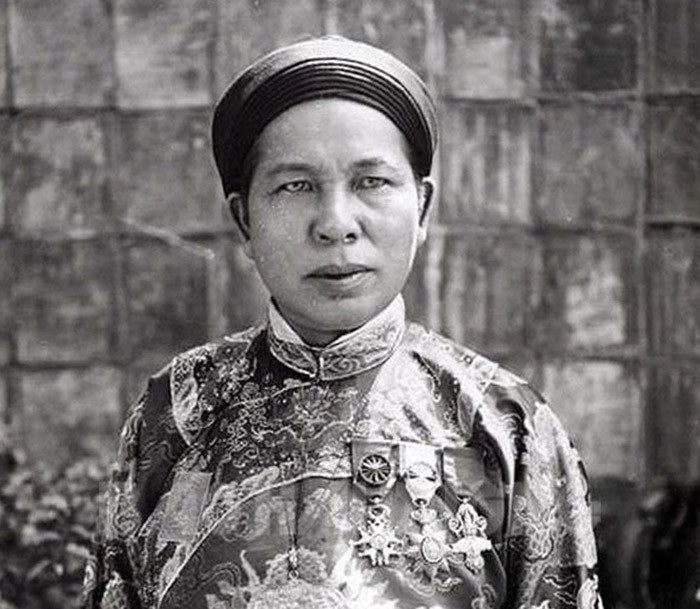Baron, Grand Minister of the Privy Council, Minister of Public Works and Minister of War Doan Dinh Duyet has many contributions to the country, people and homeland.

Hard childhood
According to the National History Institute of the Nguyen Dynasty and some historical documents, Baron and Minister Doan Dinh Duyet (1862-1929) was named Doan Dinh Nhan, with the pen name Duc Khe and the posthumous name Van Y when he was young, in Dao Lang commune, Vinh Lai district (now Van Hoi commune, Ninh Giang district, Hai Duong). Born into a poor farming family, his father died early. From a young age, he showed his intelligence, agility, and diligence, working hard day and night to herd buffaloes and cut grass to help his family. At the age of 11, because he was too busy playing and let the buffaloes eat rice, he was beaten. Doan Dinh Duyet left home for Ben Trai, Hong Phong commune (Thanh Mien) and then boarded a boat along the Luoc River. Later, he met a good person who took him in, raised him, and educated him until he grew up.
For nearly 40 years as an official, Doan Dinh Duyet held many different positions from district chief, prefect, trade minister, road inspector, governor, governor of Nghe An, Ha Tinh, Quang Ngai, Binh Dinh, Phu Yen provinces... During his tenure as well as his retirement, Baron and Grand Minister Doan Dinh Duyet clearly demonstrated his patriotism and love for the people, making many contributions to the country and his hometown Hai Duong. Baron and Grand Minister Doan Dinh Duyet was one of the four pillars of the court with a special role for the Nguyen Dynasty. He lived and worked under four Nguyen kings: Dong Khanh, Thanh Thai, Duy Tan and Khai Dinh.
Contribute to the homeland
.jpeg)
Having left his hometown since childhood, when he grew up and became an official, Minister Doan Dinh Duyet had a lot of affection for his hometown Hai Duong in general and Ninh Giang in particular. In Ninh Giang district, he gave money to hire workers to build "bamboo foot roads" to prevent flooding, and installed water wheels with horses to prevent drought in Ba Tong field. He also built Co Ngua sluice in Van Giang, Van Hoi commune; built communal houses and pagodas in Dao Lang village, Van Hoi commune. In particular, he spent his efforts and money to build and restore famous historical and cultural relics such as Tranh temple (Dong Tam commune), Trong pagoda (Hung Long commune) in Ninh Giang district and Dan Thien in Thanh Giang commune, Thanh Mien district. All three of these relics have long been ranked as national historical and cultural relics by our State, and have been promoting very positive values in the cultural life of local people. His merits and contributions are still remembered by local people and passed down from generation to generation.
Not only interested in agricultural production, Minister Doan Dinh Duyet also donated money to restore and embellish many historical and cultural relics in Ninh Giang district. According to Venerable Thich Hanh Vien, abbot of Trong pagoda in Hung Long commune (Ninh Giang), the pagoda was restored and embellished many times during the post-Le dynasty (17th-18th century). During the Nguyen dynasty (19th century), the pagoda was expanded in the style of "inner public and outer private" with a three-door gate, a gate, two houses for disarming, two Mother Goddess temples, a 7-room Dinh-shaped main pagoda, a main worship house and a Saint temple in the back. The project was built by Minister Doan Dinh Duyet to commemorate his motherland. The old pagoda was destroyed by the French colonialists. The current project was rebuilt by local people on the old foundation. The remaining three-door gate was built majestically in the unique architectural style of the Hue royal court and is the main relic still preserved to be classified as a historical relic in 2002.
According to Mr. Nguyen Van Phuc, Head of the Tranh Temple Management Board, around 1887-1888, Minister Doan Dinh Duyet contributed money and recommended many skilled craftsmen to restore and embellish the majestic Tranh Temple, with elaborate and sophisticated carvings, including the statue of Quan Lon Tuan Tranh, the three-door gate...
.jpeg)
Retired, Minister Doan Dinh Duyet lived in Ninh Giang town and passed away on January 31, 1929, at the age of 67. His tomb was located in Tranh Xuyen village, Dong Tam commune (Ninh Giang) for the first 10 years. From 1939, it was moved to Dong Thap, his hometown in Van Hoi commune, where it remains to this day.
In 2019, the People's Committee of Hai Duong province decided to name Doan Dinh Duyet street in Hai Duong city on the occasion of the 90th anniversary of his death. The street is 637 m long, with the starting point adjacent to Ngo Quyen street and the ending point adjacent to Dien Bien Phu street. Naming Doan Dinh Duyet street shows the gratitude of the Hai Duong government and people to a great mandarin in the history of the Nguyen Dynasty who made many contributions to the country and his hometown Hai Duong nearly 150 years ago.
.jpeg)
Mr. Nguyen Thanh Van, Vice Chairman of Ninh Giang District People's Committee, said that for his hometown Ninh Giang, Minister Doan Dinh Duyet had the merit of restoring and renovating two major relics, Tranh Temple and Trong Pagoda, which have been preserved and promoted their traditional cultural values to this day. No matter what position he held, he devoted all his talent and intelligence to serving and contributing to the country, his hometown and the people.
TD